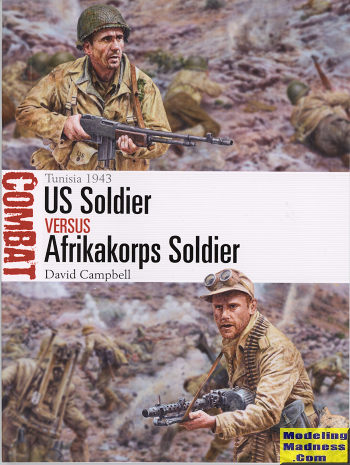 Osprey
seems to have hit on a type of book that has become fairly popular. These books
pit either soldiers or equipment against each other and allow us to see how they
perform against each other. For the equipment it is the Duel series and for
people it is this Combat series. #38 in the series pits US Army forces against
Germany's Afrikakorps.
Osprey
seems to have hit on a type of book that has become fairly popular. These books
pit either soldiers or equipment against each other and allow us to see how they
perform against each other. For the equipment it is the Duel series and for
people it is this Combat series. #38 in the series pits US Army forces against
Germany's Afrikakorps.
1943 wasn't a good year for the German army. They weren't
doing to well in Russia and in North Africa, they had been chased back west
along the coast by the British. The US had landed in Morocco and Algeria, making
it impossible to retreat in that direction. However, the British had the issue
of a very long supply line to deal with and the American army was untried in
battle. With a shorter supply line, you'd have thought all was peachy for the
Germans, but supplies were a major issue as a lot of what was needed was being
interdicted by Allied air power.
This edition is about the initial encounters between the US
and Germans in Tunisia. Typical of the series, there is a look at the opposing
sides. This includes how they are trained, their leadership, the strategic and
tactical situation at the time, the logistics situation and the morale of
troops.
Three closely timed battles are used to show the progression
of the two sides. In the first one, Sidi Zou Bid in February 1943. The US Army
did pretty much everything wrong. Their tactics were poor, their leadership at
the highest levels was lacking, and their equipment along with manpower was
insufficient to accomplish the goals. It did not help the US that troops were
green and the Germans were very experienced and led by some of the best generals
in their service, despite their dislike for each other.
Next was the Kasserine Pass just a few days later. Here,
there was some improvement in the way the Americans handled the situation as
some lessons had been learned in the previous engagement, however, the US was
still sent packing. For the Germans, despite being the clear victors, they were
unable to benefit from their advances due to the poor logistics situation and
insufficient troops to properly hold the territory gained.
After Kasserine, there was a major shake-up in the American
command structure and the wholly incapable general in charge Maj Gen Frendendall,
was fired and replaced by Maj Gen George Patton. While Fredendall's HQ was 80
miles behind the front lines, Patton was right there and was able make a major
difference in the way that the next battle at El Guttar, a month after Kasserine
was waged. Much had to do with his ability to get rid of dead wood and replace
it with capable commanders. El Guttar was a quite different situation for a
couple of reasons. One was a month to get equipment and replacements, while
another was that Rommel, one of the two main German generals, was called back to
Germany.
This all makes for a fascinating book that provides a proper
background for the two antagonists and then a good look at the three battles.
This is all enhanced by period photos, great maps, and some excellent art work
as well. Well worth picking up.
March 2019
For more on the complete line of Osprey books and to order
this one, visit
www.ospreypublishing.com
.
If you would like your product reviewed fairly and quickly, please contact
the editor or see other details in the Note to
Contributors.
 Osprey
seems to have hit on a type of book that has become fairly popular. These books
pit either soldiers or equipment against each other and allow us to see how they
perform against each other. For the equipment it is the Duel series and for
people it is this Combat series. #38 in the series pits US Army forces against
Germany's Afrikakorps.
Osprey
seems to have hit on a type of book that has become fairly popular. These books
pit either soldiers or equipment against each other and allow us to see how they
perform against each other. For the equipment it is the Duel series and for
people it is this Combat series. #38 in the series pits US Army forces against
Germany's Afrikakorps.